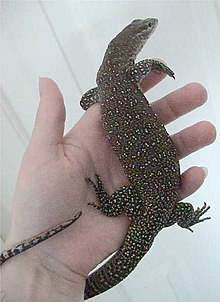
Monitor lizards are lizards in the genus Varanus, the only extant genus in the family Varanidae. They are native to Africa, Asia, and Oceania, and one species is also found in the Americas as an invasive species. About 80 species are recognized.

A goanna is any one of several species of lizard of the genus Varanus found in Australia and Southeast Asia.

The Bengal monitor, also called the common Indian monitor, is a monitor lizard distributed widely in the Indian Subcontinent, as well as parts of Southeast Asia and West Asia. This large lizard is mainly a terrestrial animal, and its length ranges from about 61 to 175 cm from the tip of the snout to the end of the tail. Young monitors may be more arboreal, but adults mainly hunt on the ground, preying mainly on arthropods, but also taking small terrestrial vertebrates, ground birds, eggs and fish. Although large Bengal monitors have few predators apart from humans who hunt them for meat, younger individuals are hunted by many predators.

The perentie is the largest monitor lizard or goanna native to Australia. It is one of the largest living lizards on earth, after the Komodo dragon, Asian water monitor, crocodile monitor, and intersecting by size with the Nile monitor. Found west of the Great Dividing Range in the arid areas of Australia, it is rarely seen, because of its shyness and the remoteness of much of its range from human habitation. The species is considered to be a least-concern species according to the International Union for Conservation of Nature.

The desert monitor is a species of monitor lizard of the order Squamata found living throughout North Africa and Central and South Asia. The desert monitor is carnivorous, feeding on a wide range of vertebrates and invertebrates.
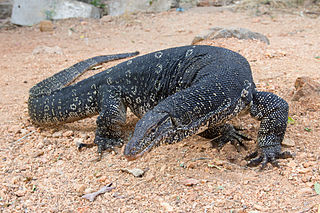
The Asian water monitor is a large varanid lizard native to South and Southeast Asia. It is one of the most common monitor lizards in Asia, ranging from coastal northeast India, Bangladesh, Sri Lanka, mainland Southeast Asia, and southern China to Indonesian islands where it lives close to water. It is listed as Least Concern on the IUCN Red List. It was described by Laurenti in 1768 and is among the largest squamates in the world.
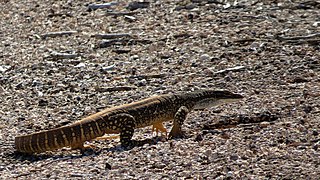
The sand goanna is a species of large Australian monitor lizard, also known as Gould's monitor, sand monitor, or racehorse goanna.

The black tree monitor or Beccari's monitor is a species of lizard in the family Varanidae. The species is a relatively small member of the family, growing to about 90–120 cm (35–47 in) in total length. V. beccarii is endemic to the Aru Islands off New Guinea, living in an arboreal habitat. The skin color of adults is completely black, to which one common name refers.
The short-tailed pygmy monitor is the second smallest living monitor lizard in the world with a maximum length of 25 cm.

The emerald tree monitor or green tree monitor, is a small to medium-sized arboreal monitor lizard. It is known for its unusual coloration, which consists of shades from green to turquoise, topped with dark, transversedorsal banding. This coloration helps camouflage it in its arboreal habitat. Its color also makes the emerald tree monitor highly prized in both the pet trade and zoos alike.

The yellow-spotted monitor, also known as the Argus monitor, is a monitor lizard found in northern and western regions of Australia and southern New Guinea.

The spiny-tailed monitor, also known as the Australian spiny-tailed monitor, the ridge-tailed monitor the Ackie's dwarf monitor, and colloquially simply ackie monitor, is an Australian species of lizard belonging to the genus of monitor lizards (Varanus).

The Gray's monitor is a large monitor lizard known only from lowland dipterocarp forest in southern Luzon, Catanduanes, and Polillo Island, all islands in the Philippines. It is also known as Gray's monitor lizard, butaan, and ornate monitor. It belongs to the subgenus Philippinosaurus. It is largely arboreal and extremely shy. The Northern Sierra Madre monitor lizard was thought to be of same species with Gray's monitor until a research concluded in 2010 that northern populations of Gray's monitor was a distinct species, now known as V. bitatawa.

The rock monitor is a species of monitor lizard in the family Varanidae. The species is endemic to Central, East, and southern Africa. It is the second-longest lizard found on the continent, and the heaviest-bodied; locally, it is called leguaan or likkewaan.
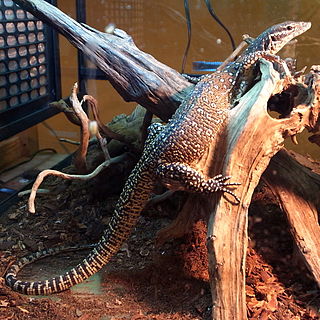
The peacock monitor, also known commonly as Auffenberg's monitor, is a species of small monitor lizard in the family Varanidae. The species, which belongs to the subgenus Odatria, is endemic to Rote Island, Indonesia.

The black-headed monitor or black-tailed monitor is a relatively small species of monitor lizards native to Australia. It is occasionally also called the mournful monitor, freckled monitor or the racehorse monitor, a name it shares with the Gould's monitor due to their exceptional speed. It is placed in the subgenus Odatria.

The Rosenberg's monitor is an Australian species of varanid reptile found in southern regions of the continent. They are large and fast predators with rugged bodies and long tails, having a combined length up to 1.5 metres, that will consume any smaller animal that is pursued and captured or found while foraging. They occur in the Australian Capital Territory, New South Wales, South Australia, Victoria, where it may be rare or locally common, and more frequently observed in Western Australia, where it is sometimes abundant.

Varanus kordensis, the Biak tree monitor, is a member of the Varanidae family found on Biak Island in Indonesia. It is also known as the Kordo tree monitor. Long considered a subspecies of the emerald tree monitor, most authorities now treat it as a separate species.
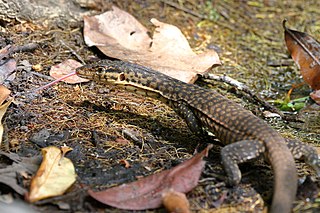
Mitchell's water monitor is a semiaquatic species of monitor lizard in the family Varanidae. The species is native to Australia. The species is native to the Northern regions of Australia, and is on IUCN's Red List as a critically endangered species. They can be distinguished by the orange or yellow stripes along their neck and dark spots along their back. They are mainly carnivorous, and eat small prey such as lizard, birds, and insects.
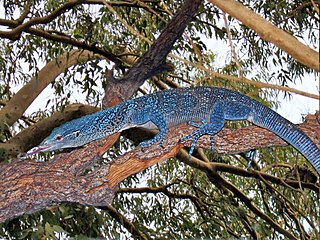
Varanus macraei, the blue-spotted tree monitor or blue tree monitor, is a species of monitor lizard found on the island of Batanta in Indonesia. It is named after herpetologist Duncan R. MacRae, founder of the reptile park Rimba on Bali.
